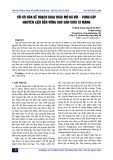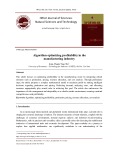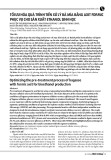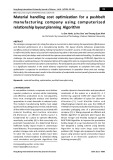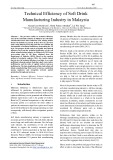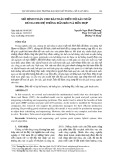
* Corresponding author
E-mail address:mfrutos@uns.edu.ar (M. Frutos)
© 2019 by the authors; licensee Growing Science, Canada
doi: 10.5267/j.uscm.2018.10.005
Uncertain Supply Chain Management 7 (2019) 203–214
Contents lists available at GrowingScience
Uncertain Supply Chain Management
homepage: www.GrowingScience.com/uscm
A memetic algorithm for the integral OBP/OPP problem in a logistics distribution center
Fabio Miguela, Mariano Frutosb*, Fernando Tohméc and Daniel A. Rossitb
aSede Alto Valle y Valle Medio, Universidad Nacional de Río Negro. Villa Regina, Argentina
bDepartment of Engineering, Universidad Nacional del Sur and IIESS-CONICET. Bahía Blanca, Argentina
cDepartment of Economics, Universidad Nacional del Sur and INMABB-CONICET. Bahía Blanca, Argentina
C H R O N I C L E A B S T R A C T
Article history:
Received September 9, 2018
Accepted October 12 2018
Available online
October 12 2018
In this paper, we present a new decision-making tool aimed at improving the efficiency of the
operational planning of pick-up processes in logistic distribution centers. It is based on a memetic
algorithm (MA) solving both the Order Batching Problem (OBP) and the Order Picking Problem
(OPP). The result yields a sequence of simultaneous pick up operations of lots for different
clients in a storing facility, satisfying a previously defined distribution plan. The objective is the
minimization of the operational cost of the entire process, which is directly proportional to the
time spent on different activities involved. The failure to satisfy the conditions, either leads to
overstocking, delays in delivery or creates inefficiency costs. The analysis of the results obtained
with our algorithmic tool indicates that it has a good performance in comparison with other
known algorithms used to solve this kind of problem.
Growin
g
Science, Canada ensee
by
the authors; lic9© 201
Keywords:
Order Batching Problem
Order Picking Problem
Optimization
Logistics
1. Introduction
The optimization of processes in a distribution center is a critical factor for the operational performance
of the internal and external logistics of the firm. These operational processes, as for instance reception,
placement, storing, selection, order picking, classification and dispatch, involve moving goods inside
distribution centers (Biswas & Das, 2018).
Depots or storage sites play different roles according to the logistic system in which they are used.
This, in turn, has consequences for the optimal use of those spaces. One of these roles is crucial in
extended or permanent storage systems, i.e. systems in which the records of activity of products indicate
frequencies of access to long-term storage positions. The main goal of the optimization of processes in
this kind of system is the efficient use of space while optimal speed of access and flow of materials is
not a priority. A different kind of storage site is used in active storage systems, whose main function is
not to store wares for long periods of time but to facilitate the distribution of goods. Here the goal is
the efficient management of a variety of goods and the flow of products between areas with different
functionalities inside the same facility.

204
The specific features of the activities involved in the aforementioned processes depend on the nature of the
system and the particularities of each case. According to De Koster et al. (2007), these activities can be
described as follows. The reception of merchandise requires unloading the wares from a transportation unit,
storing them in the depot, updating the inventory registry and inspecting them to detect the presence of
inconsistencies in the declared amount, quality and packaging. The put away process consists in moving
the goods from the docking site to their placement in the store, registering all the information that allows
their localization. Order picking/selection is the main process in most depots. It consists in picking up from
the storing places the requested goods and transporting them to the delivery preparation zone. The
classification/unitarization of the selected requests consists in regrouping the units corresponding to a
specific client. In most cases this process involves labeling and packing an indivisible unit. Dispatch is the
process in which each of those units is checked out to verify that the request is fulfilled, transportation
documents are signed and the goods are loaded on a transportation vehicle.
In this paper we analyze only one of the aforementioned activities. More specifically, we study the
optimization of the order picking/selection process in the context of active storage systems.
2. The problem and literature review
We can identify three different planning problems related to moving goods from and to depots. One is the
allocation of incoming goods in the storage sites. The other is allocating items for delivery. And finally
there is the problem of sequencing the pick-up of goods to transfer them to dispatch areas (Henn & Wäscher,
2012). In this article we focus on the integrated treatment of these last two problems, which are critical for
the efficiency of the depot operations and involve most of the costs since they require an intensive use of
labor (Hwang & Kim, 2005; Rana, 1991; Janaki et al., 2018).
To understand this we have to present a detailed description of the order picking/selection process. It
starts with an income order for the preparation of a certain amount of goods, requested by clients,
detailing the precise specification of articles in the storage site, defining the dates at which each request
has to be available in the dispatch area (deadlines). These dates are defined in terms of both the delivery
schedule and the time necessary for completing the unitarization and dispatch process. The items have
to be picked out in due time, which requires specifying a schedule of visits to different sites. Once
finished this operation, the operators return to the dispatch area.
The integral problem amounts to minimize the operational cost of pick-ups, giving a due date for the
finishing of each request. That cost is directly proportional to the time devoted to get the goods to the
dispatch area and the time necessary to finish the requests.
It is important to note that after finishing the requested lots, they must be transferred to the delivery
services, which posit further constraints on the pick-up process. If the finishing phase induces delays
in the delivery, the ensuing penalty costs will render the entire plan inefficient. On the other hand, if
the goods reach the dispatch areas earlier than necessary, new costs arise because of the inefficient use
of those areas, blocking the flow of activities and increasing their processing times.
Formally, this integrated planning problem is composed of two NP-Hard sub-problems, the Order
Batching Problem (OBP) (Zulj et al., 2018; Menéndez et al., 2017) and the Order Picking Problem (OPP)
(Rana, 1991). The OBP amounts to determine the optimal quantity and size of lots to be picked up, taking
into account the capacity of pick-up equipment and the time at which each article has to reach the dispatch
area for finishing. The OPP, in turn, consists in identifying optimal sequences of visits to storing sites,
minimizing the distance covered and the time spent in route, visiting each place just once. The joint
problem will be denoted OBP/OPP.

F. Miguel et al. / Uncertain Supply Chain Management 7 (2019)
205
De Koster et al. (2007) review the literature on order batching and picking. Heuristics for OPP with a single
operator can be found in Petersen (1997) and Theys et al. (2010). De Koster et al. (1999) review the classic
heuristics applied to the basic pick-up problem. Two main techniques have been used, Ant Colony
Optimization and Iterated Local Search (Henn et al., 2010). Other meta-heuristics applied to the OBP use
clustering based on pattern of demand instead of distances covered (Ho & Tseng, 2006; Chen & Wu, 2005;
Arora et al., 2017). Henn et al. (2012) present several heuristics for the OBP while Lam et al. (2014) state
the OBP as an integer programming problem in which the distances covered in each sequence of visits is
estimated and the problem is solved by a heuristic based on fuzzy logic. Tsai et al. (2008) use a multiple
genetic algorithm to solve the OBP/OPP. They apply flexible time windows for the delivery of goods,
penalizing requests finished after or before the time specified by the program.
Here we follow the lead of the latter authors but using a hybrid evolutionary algorithm with a constructive
heuristic that uses local search. With this we intend to get improved results on the instances and layouts
proposed in the literature.
3. The proposed model
In this section we present a mixed-integer linear programming (MILP) formulation of the problem
(Öncan, 2015). We define the decision variables, the goal function and the constraints of the OBP/OPP,
taking into account the delivery deadlines, m picking equipment units and the operational constraints
of the store.
Parameters and variables
1,…, is a set of different kinds of articles. Each one has a different weight, and the
set of unitary weights is
,…,,…,.
is the set of articles requested by client . We assume that each client makes only one request of
several articles with different amounts of them. The class of clients is 1,…,,…,. Each
request has a deadline, and the set of those deadlines is ,…,,…,.
is the class of articles in lot . ℓ
,ℓ,…,ℓ,…,ℓ are the storing positions of each type of
article plus ℓ, the dispatch area in the depot. For instance, for ∈, position ℓ is given by the
coordinates in the storage floor, i.e. ℓ
,
. 1,..,,…,|| denotes the lots to be picked
up.
〈,…,,…,||〉 is the route to be covered to get lot . That is, ∈ and is the
storage position to visit to build lot and || the number of different articles in that lot.
represents the amounts requested of each type of article by all the clients. So , ∈ indicates how
many units client requests of article . Thus, ∑,∈ is the total number of units of articles
requested by while ∑,∈ is the total amount of units requested of good . Similarly, is
the number of units included in lot . Finally, 1,…,|| is the class of pick up equipment units,
each with capacity . Then, OBP/OPP defines an undirected graph ,, where: are the
nodes, representing the storage positions, one for each ∈, plus two copies (0 and 1) of the
node representing the dispatch area. On the other hand represents the set of edges, such that each
,∈ has an associated time given by the distance between and divided by the speed
of a unit of pick up equipment, (i.e.
,
⁄) with an operational cost of each unit of time, .
Then, is the average pick-up time, once the operator has reached a storing position.

206
Binary flow variables:
1 iff an article is picked up immediately before article by the equipment in the sequence
of lot , where , ∈ , ∈ and ∈. That is, it is 1, iff equipment in order to pick up lot goes
through ,.
Binary index variables:
1 iff picking equipment unit picks up article in lot , where ∈, ∈ and ∈.
3.1 MILP model of OBP/OPP
min:
∑∑, ∑∑∈∈∈∈
∈
∈
∈
(1)
subject to
∑
∈ ∀ ∈
,∈
(2)
∑∈ 1 ∀ ∈
,∀∈
(3)
∑∈ || ∀ ∈ 0, 1,∈
(4)
∑∈
∀ ∈
∖0,∈
,∈
(5)
∑∈
∀ ∈
∖1,∈
,∈
(6)
∑∑ ∑ ,
∈∈∈
∀ ∈
(7)
∑∑∑,
∈∈∈
∀ ∈
(8)
∈0,1 ∀, ∈
,∈
,∈
(9)
∈0,1 ∀ ∈
,∈
,∈
(10)
The goal function (1) represents the total cost expressed in monetary units per time unit spent in
collecting the lots of problem OBP/OPP, plus a penalty term for not finishing the task in time. The first
term involves the displacement time to the storing site plus the pick-up time. The displacement time
obtains as the time required covering the distance at the average speed of operators. This, in turn, results
adding the distances covered in the route assigned to each operator. The penalty for either anticipation
or delay respect the deadline, is obtained in terms of and , the penalty cost of each unit of time of
anticipation and delay, respectively. represents the anticipation in finishing request while is the
delay in doing that. We have that 0, and 0,
, where is the
effective finishing time of request , defined as the time in which all the articles of request are picked
up and returned to the dispatch area. Constraint (2) forbids the weight of a lot to exceed the capacity of
a pick-up equipment unit. (3) Indicates that each storing position cannot be visited more than once for
each lot . (4) Ensures that pick-up equipment units start and end their routes at the dispatch area.
Constraints (5) and (6) preserve the flow. If equipment unit picks up article in lot , it has to have
picked up article if h is before l in the order. If the contrary is true, then has to pick up before
picking up h. Constraint (7) indicates that all the requests of article are satisfies. (8) indicates that the
request of each client has to be satisfied. Finally (9) and (10) impose conditions on the values of
variables.

F. Miguel et al. / Uncertain Supply Chain Management 7 (2019)
207
Depot layout
Fig. 1 shows a layout of a storage center in the OBP/OPP.
Fig. 1. Layout of a depot
In the lower left corner we can find the access to the dispatch area, the starting and ending point of the
routes covered by all the operators with picking up equipment units. The operator leaves the dispatch
area, goes to a specific storage position, picks up the articles, and then moves to the next position in
her route. She keeps doing this until all the units in a lot are picked up and then she returns to the
dispatch area. To solve the formal problem we assume that all the storing positions of each type of
article are known. This means, in turn, that all the articles of the same type are stored in a single position.
In red we have depicted the areas in which the operations required to solve OBP/OPP are performed.
In this we follow Tsai et al. (2008), a reference which we will use to validate the model and test our
computational tool. In order to do that, we respect the layout parameters given by those authors. That
is, we consider two lateral and two double center shelves as well as two transversal and three
longitudinal walking aisles. In this configuration, the distance from the place of article to that of article
, i.e. from ℓ to ℓ, where ℓ
, and ℓ
,, can be stated as:
Receiving
dock
Shipping
dock
Dispatch Area
Receiving Staging Area
Cross Aisle
Cross Aisle
Picking Aisle
Picking Aisle
Picking Aisle
BOPP
l
1
l
2
x
2
,y
2
x
1
,y
1
l
nPed
x
nPed
,y
nPed
Y
(0,H)
Storage
Area
Storage
Area
Storage Area
Storage Area




